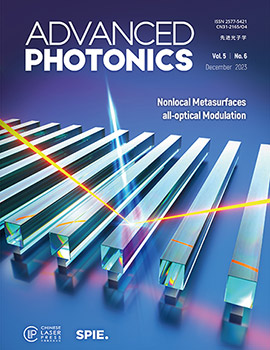Neuromorphic silicon photonics with 50 GHz tiled matrix multiplication for deep-learning applications
IF 18.8
1区 物理与天体物理
Q1 OPTICS
引用次数: 6
Abstract
Abstract. The explosive volume growth of deep-learning (DL) applications has triggered an era in computing, with neuromorphic photonic platforms promising to merge ultra-high speed and energy efficiency credentials with the brain-inspired computing primitives. The transfer of deep neural networks (DNNs) onto silicon photonic (SiPho) architectures requires, however, an analog computing engine that can perform tiled matrix multiplication (TMM) at line rate to support DL applications with a large number of trainable parameters, similar to the approach followed by state-of-the-art electronic graphics processing units. Herein, we demonstrate an analog SiPho computing engine that relies on a coherent architecture and can perform optical TMM at the record-high speed of 50 GHz. Its potential to support DL applications, where the number of trainable parameters exceeds the available hardware dimensions, is highlighted through a photonic DNN that can reliably detect distributed denial-of-service attacks within a data center with a Cohen’s kappa score-based accuracy of 0.636.神经形态硅光子学与50 GHz平铺矩阵乘法深度学习应用
摘要深度学习(DL)应用的爆炸式增长引发了一个计算时代,神经形态光子平台有望将超高速和能效证书与受大脑启发的计算原语相结合。然而,将深度神经网络(DNN)转移到硅光子(SiPho)架构上需要一个模拟计算引擎,该引擎可以以线速率执行平铺矩阵乘法(TMM),以支持具有大量可训练参数的DL应用,类似于最先进的电子图形处理单元所遵循的方法。在此,我们展示了一个模拟SiPho计算引擎,该引擎依赖于相干架构,可以以创纪录的50 GHz高速执行光学TMM。通过光子DNN,它可以可靠地检测数据中心内的分布式拒绝服务攻击,基于Cohen’s kappa评分的准确度为0.636,突出了它支持DL应用的潜力,在DL应用中,可训练参数的数量超过了可用的硬件尺寸。
本文章由计算机程序翻译,如有差异,请以英文原文为准。
求助全文
约1分钟内获得全文
求助全文
来源期刊

Advanced Photonics
OPTICS-
CiteScore
22.70
自引率
1.20%
发文量
49
审稿时长
18 weeks
期刊介绍:
Advanced Photonics is a highly selective, open-access, international journal that publishes innovative research in all areas of optics and photonics, including fundamental and applied research. The journal publishes top-quality original papers, letters, and review articles, reflecting significant advances and breakthroughs in theoretical and experimental research and novel applications with considerable potential.
The journal seeks high-quality, high-impact articles across the entire spectrum of optics, photonics, and related fields with specific emphasis on the following acceptance criteria:
-New concepts in terms of fundamental research with great impact and significance
-State-of-the-art technologies in terms of novel methods for important applications
-Reviews of recent major advances and discoveries and state-of-the-art benchmarking.
The journal also publishes news and commentaries highlighting scientific and technological discoveries, breakthroughs, and achievements in optics, photonics, and related fields.
 求助内容:
求助内容: 应助结果提醒方式:
应助结果提醒方式:


